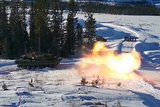MEADS fire control radar completes 6-week test
The Multifunction Fire Control Radar (MFCR) for the Medium Extended Air Defense System (MEADS) has completed a six-week performance test at Pratica di Mare Air Force Base near Rome, Italy, and at MBDA Germany’s air defence centre in Freinhausen.
The testing, which is the first time the MFCR has been operated in Germany, saw the system successfully demonstrate advanced critical capabilities, including tracking and cancelling jamming signals; searching, cueing and tracking in ground clutter; and successfully classifying target data using kinematic information.
MEADS radars are designed to provide360-degree protection for troops and assets against aerial threats, including missile attacks. Using plug-and-fight capability, the MFCR acts as a node on the MEADS network, and can be dynamically added or removed as missions dictate without shutting down the system.
Siegfried Bücheler, director programs and supply chain, MBDA Germany, and chairman of the Board of Directors, MEADS International, said: ‘The latest test gives again evidence of the maturity of the MEADS development results. They form an excellent basis for Germany’s TLVS future air defence system. A future air defence system based on MEADS technologies is designed to fulfil requirements for an advanced tactical air and missile defence system that anticipates future threats. Competing systems would require further development for achieving the advanced MEADS capabilities.’
The X-band MFCR employs active phased array technology using transmit/receive components developed in Germany. It provides precision tracking and wideband discrimination and classification capabilities. An advanced Mode 5 Identification Friend or Foe subsystem allows for improved threat identification. If required, the radar can provide full fire control and limited surveillance capabilities.
Marco Riccetti, technical director, MEADS International, added: ‘We are thrilled with the maturity of this radar. The MFCR has an extraordinary capability to detect and track ballistic missiles, cruise missiles, aircraft and unmanned aerial vehicles. Its 360-degree capabilities provide added protection against next-generation threats for military sites and civilian populations.’
More from Land Warfare
-
Germany signs multi-billion-dollar deals for 6x6 CAVS and GDELS Eagle vehicles
The order is a further boost for the Common Armoured Vehicles System programme which has notched notable successes in the past 12 months. The first vehicle, made in Finland, will be delivered next year with local production expected to ramp up in 2027.
-
![Rheinmetall and KNDS tank tie-up narrows trans-European options]()
Rheinmetall and KNDS tank tie-up narrows trans-European options
The French and German governments signed an agreement in June 2018 to cooperate on the development of a new main battle tank under the Main Ground Combat System programme but the effort has struggled. This new agreement may damage it further.
-
![2025 land market review: British Army woes, European heavy armour and US MBT progress]()
2025 land market review: British Army woes, European heavy armour and US MBT progress
The last year has seen several major procurements in the land market. Shephard’s Dr Peter Magill reviews the main trends and themes in land procurement of 2025.
-
![Hungary set to begin using Hero 400 loitering munitions]()
Hungary set to begin using Hero 400 loitering munitions
Developed by Israel's Uvision and with systems being sold in the thousands to multiple European NATO countries and the US, the Hero family of loitering systems is also in production in the US and Italy, the latter through Rheinmetall.
-
![Croatia orders Leopards and CAESAR howitzers as Lithuania orders more CAESARs]()
Croatia orders Leopards and CAESAR howitzers as Lithuania orders more CAESARs
The Leopard is becoming the tank of choice in central and eastern Europe as Croatia joins Lithuania, the Czech Republic and Hungary in ordering the platform. Lithuania and Croatia have also signed for CAESAR howitzers.
-
![Light Reconnaissance Strike – enabling a vital mission set (Studio)]()
Light Reconnaissance Strike – enabling a vital mission set (Studio)
A new system-of-systems concept will unlock digital integration of sensors and weapons for Light Forces, allowing them to shape the battlefield environment on their own terms and upgrade legacy platforms.


























